I am here at Mugaritz to engage in a tasting experience which was meant to be pretty unique. Mugaritz is a pioneer in creative and experimental molecular gastronomic cuisine. Under the supervision of Chef Andoni Luis Aduriz, Mugaritz provides guests with little “tastes” over 25 courses.
Here is a lovely photo of their gardens and outdoor area.
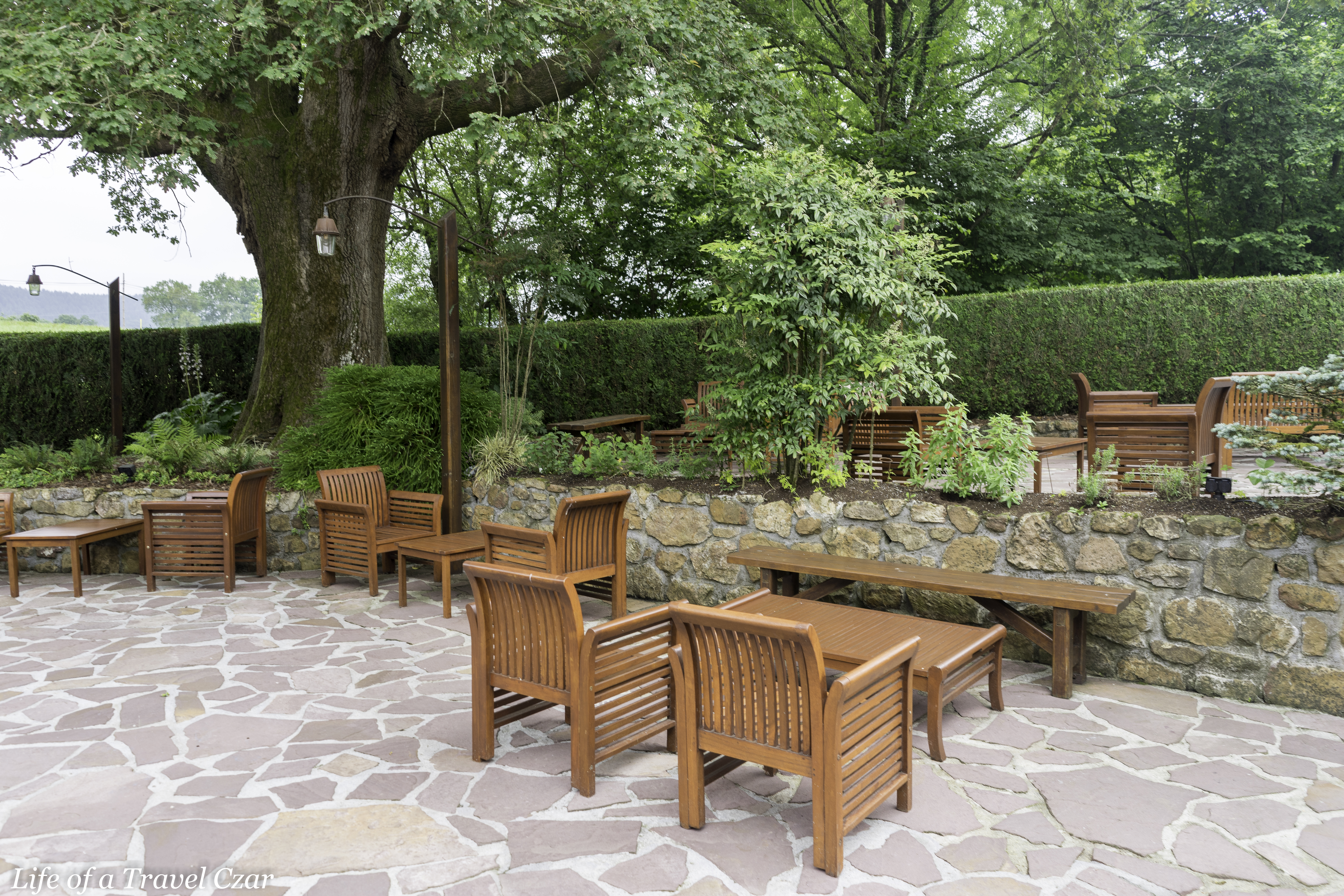
This is my table with a view of the courtyard and a split plate as the table centrefold.

I am seated and start with an apertif.
Gosset Champagne



A good apertif. It has fresh lemon aromas with a hint of brioche notes. On the palate the flow of beautiful lemon peel, sweet nougat, toasted nuts and zesty minerality make for a refreshing taste experience.
Crunchy Asparagus Threads and Macerated Anchovy

This is a white asparagus with a gel and some fermented sardine mixed through. The dish has the noticeable salinity of the sardine and stringy texture on the palate.
Ca N’Estruc, BI 273, Muscat, Catalonia, Spain.

This is the base wine as not all the dishes are paired. So if the dish is not paired then it defaults to this wine as the pair for that particular dish.
Ca N’Estruc is an old vineyard which is 165m above ground on the Montserrat Mountain close to the town of Esparreguera and Barcelona. This is a muscat and it’s a very basic as it needs to be paired with a variety of dishes. There are some nice floral and fruity aromas which flow into some good fruit flavours; peaches and citrus fruit. The wine is sweet with some decent acid structure for balance. It’s not overly impressive.
Creamy Escabeche
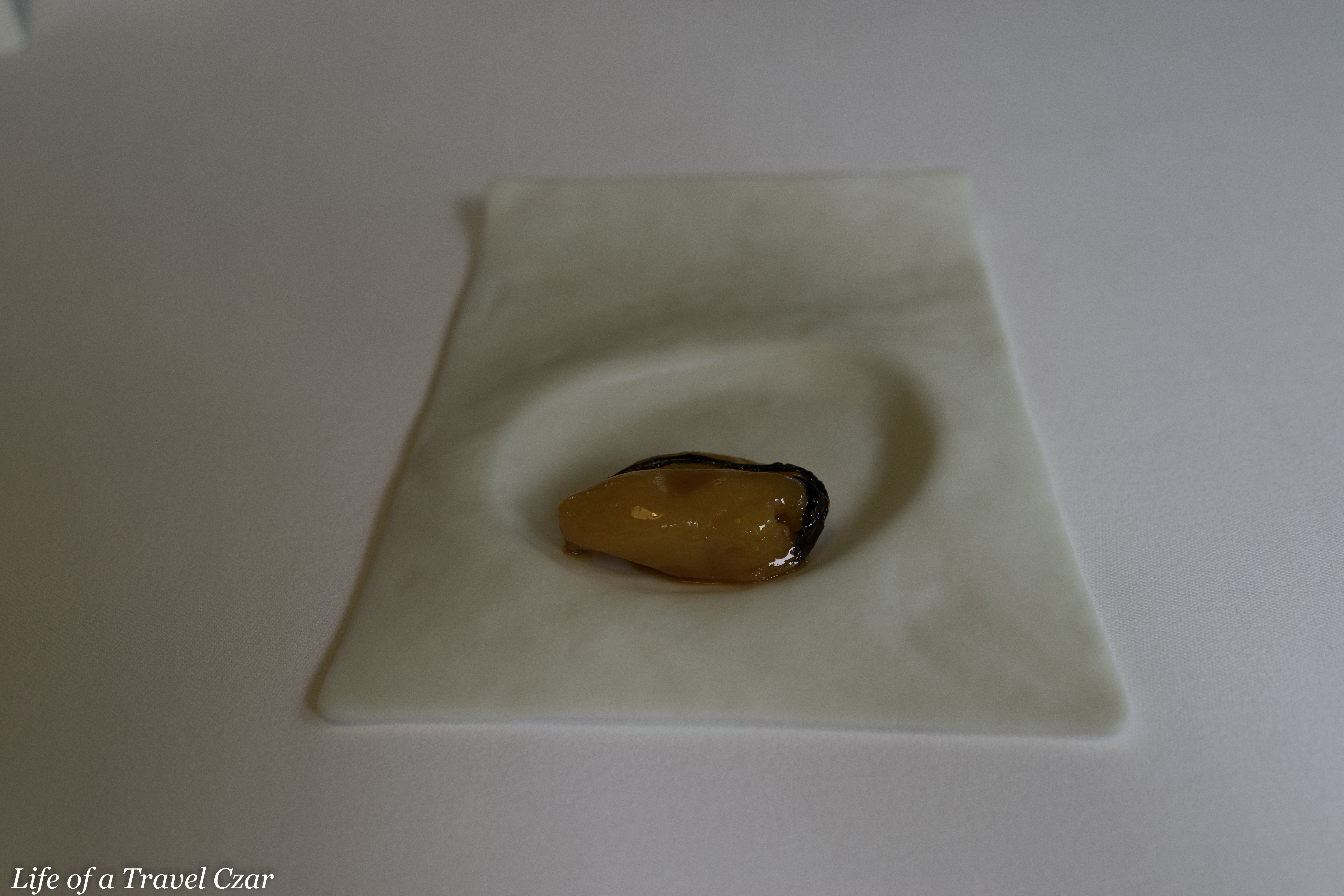
This dish is not a mussel. Apparently it is a preserved pumpkin shaped like a mussel. There isn’t the natural flavour of the mussel which tips one off, in fact there is sweet undertone to the dish. The texture is slimy and the colour and glaze reflects a pickled preserve.
“Vegan Oyster Scallop”

This is a fungus with truffle on top and sweet base of a cultured Riesling. There is a beautiful earthiness to the dish which contrasted with the sweet base.
Joh. Jos. Prüm Wehlener Sonnenuhr Riesling, (1999) Auslese, Germany

The next wine is a Riesling from the Mosel River Valley. in Germany. On the nose there is beautiful mix of ripe citrus fruit, apple, anise and floral notes. On the palate the wine has beautiful apple and lemon flavours and spice and honey notes. The wine proves very drinkable with a moderate acidity but there is a real mineral purity to the wine which makes for a refreshing flow on the palate.
A Cultured Molecule: Aged Riesling and Caviar

This dish is well constructed for the Riesling. The caviar is wrapped with a rice based pasta (mochi) with some oil mixed in. An isotope of the Riesling is captured and infused into the mochi. There is the saline burst of the caviar which is a lovely contrast to the sweet starch and Riesling infusion. The textural contrast between the caviar and mochi is wonderful and delivers a nice experience on the palate. The choice of wines for this dish is perfect.
Lobster Roe and Tiger’s Milk

This would have to be one of my favourite dishes of the afternoon. The lobster roe is placed in a bed of tiger’s milk. To clarify the Tiger’s Milk is the green sauce; it’s a Peruvian sauce with celery and green pepper.
There is the richness of the roe mixed with the mildly acidic Tiger’s Milk. The dish is reminiscent of the Nobu triangle; rich seafood, acidic sauce and a wine with fresh minerality and acid. It fires on all cylinders.
Bollinger La Grande Année (2005)
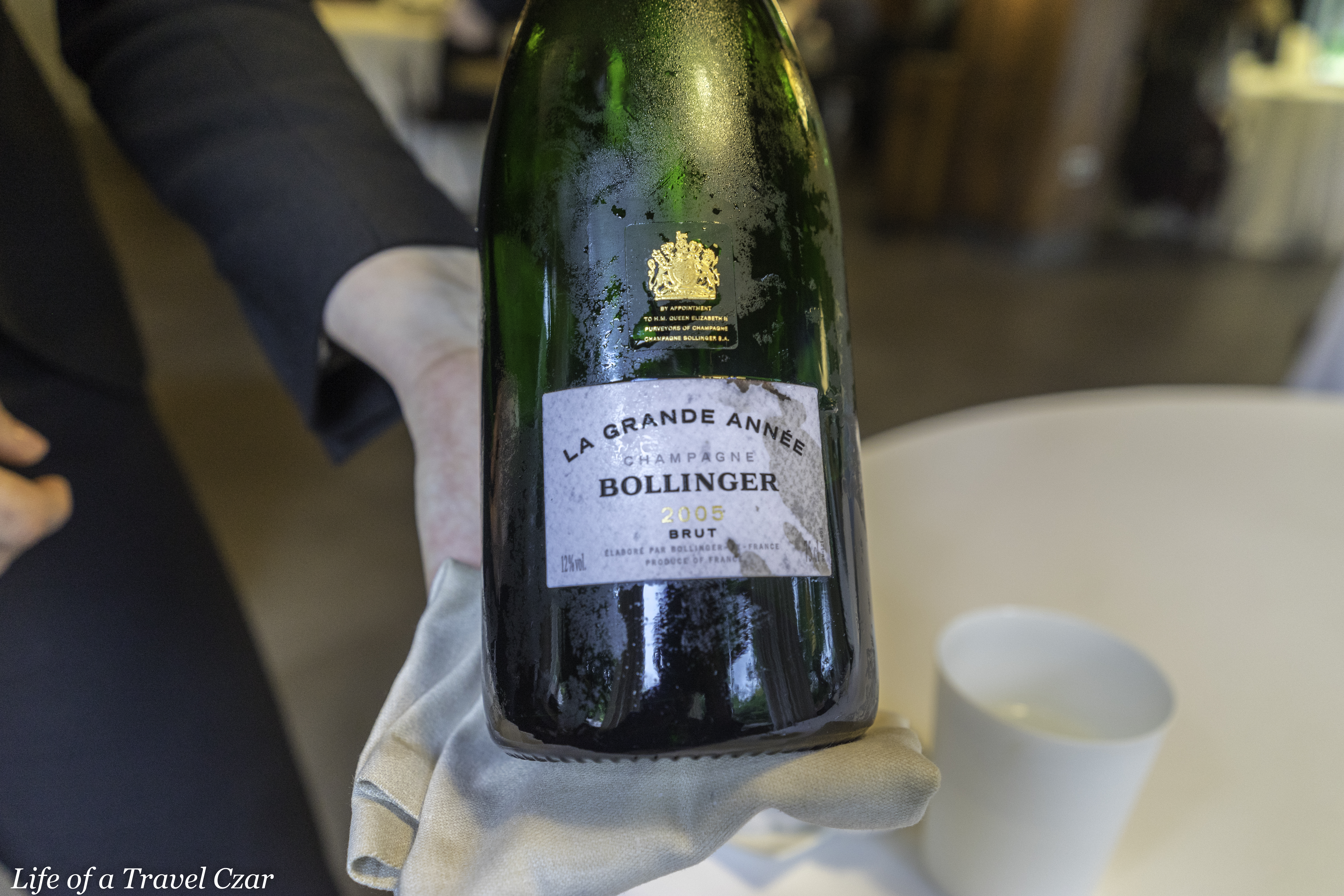
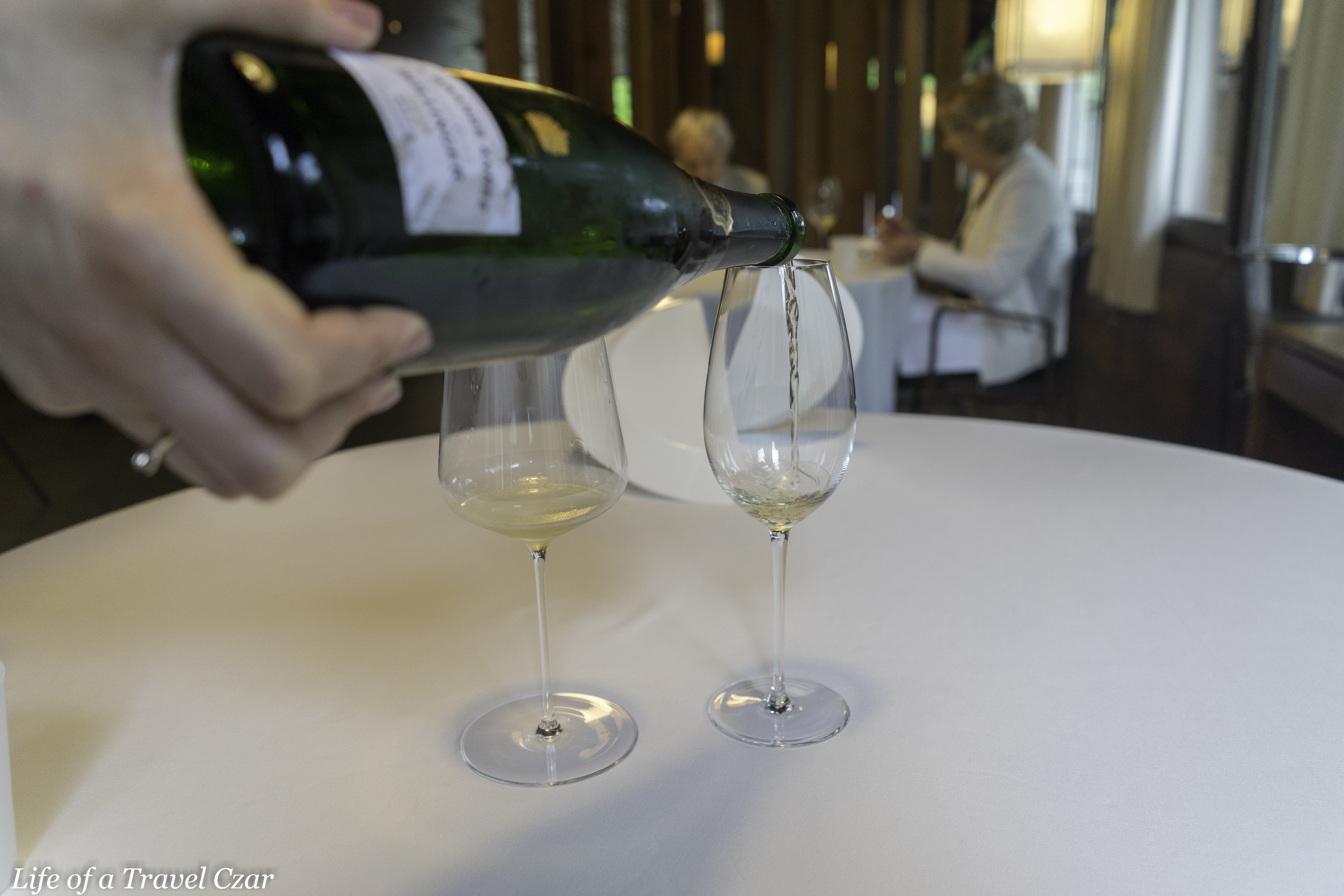
This is a very special wine. It’s got bright green apple, brioche and nutty aromas with some light floral notes. On the palate it’s all about the beautiful tart apples, almonds and fresh minerals. It’s refreshing; good fruit and some solid acid to stand behind it.
A bitter veiled oyster
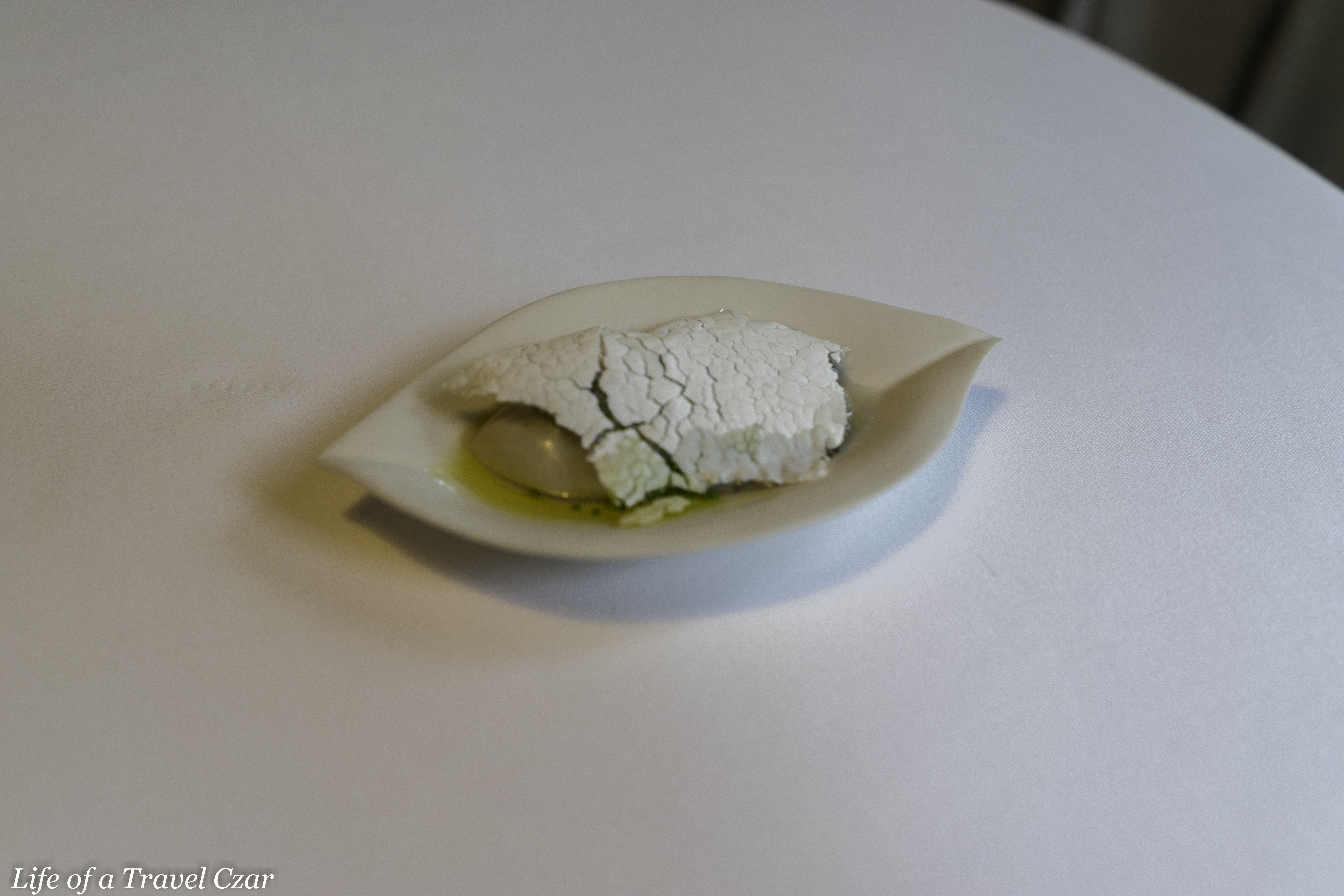
The dish is an oyster with lemon juice and fermented rice on top. There is a textural contrast of the crispy powdery rice and the slimy oyster. The acidity and richness of the oyster go hand in hand. The rice makes a dry sensation on the mouth is fixed by the oyster and lemon juice’s moisture. The Bollinger worked a treat here; richness, salinity and acidity all intertwined.

Head Cheese of “Kokotxas”

Don’t let the name mislead you, the dish is a terrine of cod with cod sauce, peppers and flowers. The cod has its natural flavour on display, the peppers and flowers refresh the palate after the rich creamy cod sauce flows through. It’s actually a good contrast of tartness, cream and natural salinity.
Ca N’Estruc, BI, Sumoll, Catalonia, Spain.
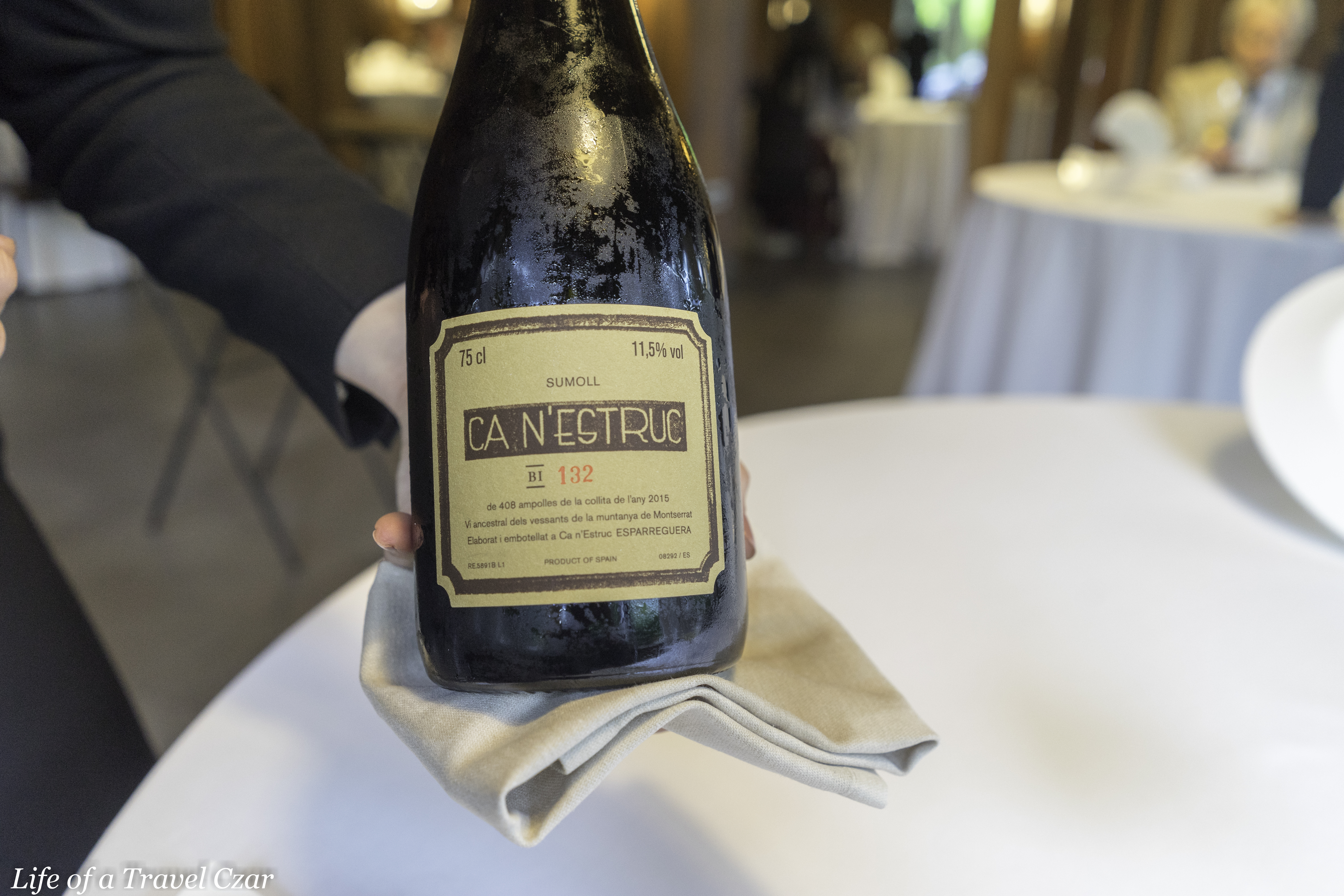
This is from the same vineyard as the base wine. It’s a chilled red wine from Catalonia. It has only one fermentation rather than the standard two. The wine has fresh berry aromas with a hint of floral notes and a little spice which flows onto the palate. There’s a lot of fruit and spice and a decent amount of acidity to balance.
Strawberries and Cream

This was a strawberry cream mix with kombucha jelly. This course and the wine pairing is probably my least favourite. The dish is super sweet and lacking in any complexity.
St George’s Mushroom and Onion

The dish is local spring mushrooms with onion oil and cosmos leaves. The dish has a raw, nutty, earthy flavour. It’s nothing impressive and not sure of its place or purpose in the tasting.
Aged Mole Leaves and Bone Marrow

The dish is a crispy chocolate nut constructed leaves and vegetable with a tendon butter (Its basically beef tendon made like butter). I liked this dish; the cacao notes and the richness and smoky tendon butter was a dream. The powder, the butter and the crispy leaves were an array textures.

However disappointingly, I would have thought that a different wine should be selected for the pairing… alas I was stuck with base wine.
Gonzalez Byass Fino Una Palma


The sherry has beautiful aromas of some apples, brioche and honey. It’s a little less expressive on the nasal senses as other sherries I have tasted. There is a real buttery richness as it flows on the palate with a mix of apple, pears and quince flavours. The sweetness is short-lived with an intense sourness and salinity in the finish.
Brioche of Olive and a “Manzanilla”s veil

The dish is a black olive brioche with white flower cream. The deep tart saline flavours of the olive with the bready texture of the brioche is contrasted with the smooth floral notes in the cream. It’s not exactly a masterpiece but there was thought put into its construction. The saline finish of the Sherry is a gem in terms of pairing with the dish.
Chilled Consomme from 2014, roe and cuckooflower
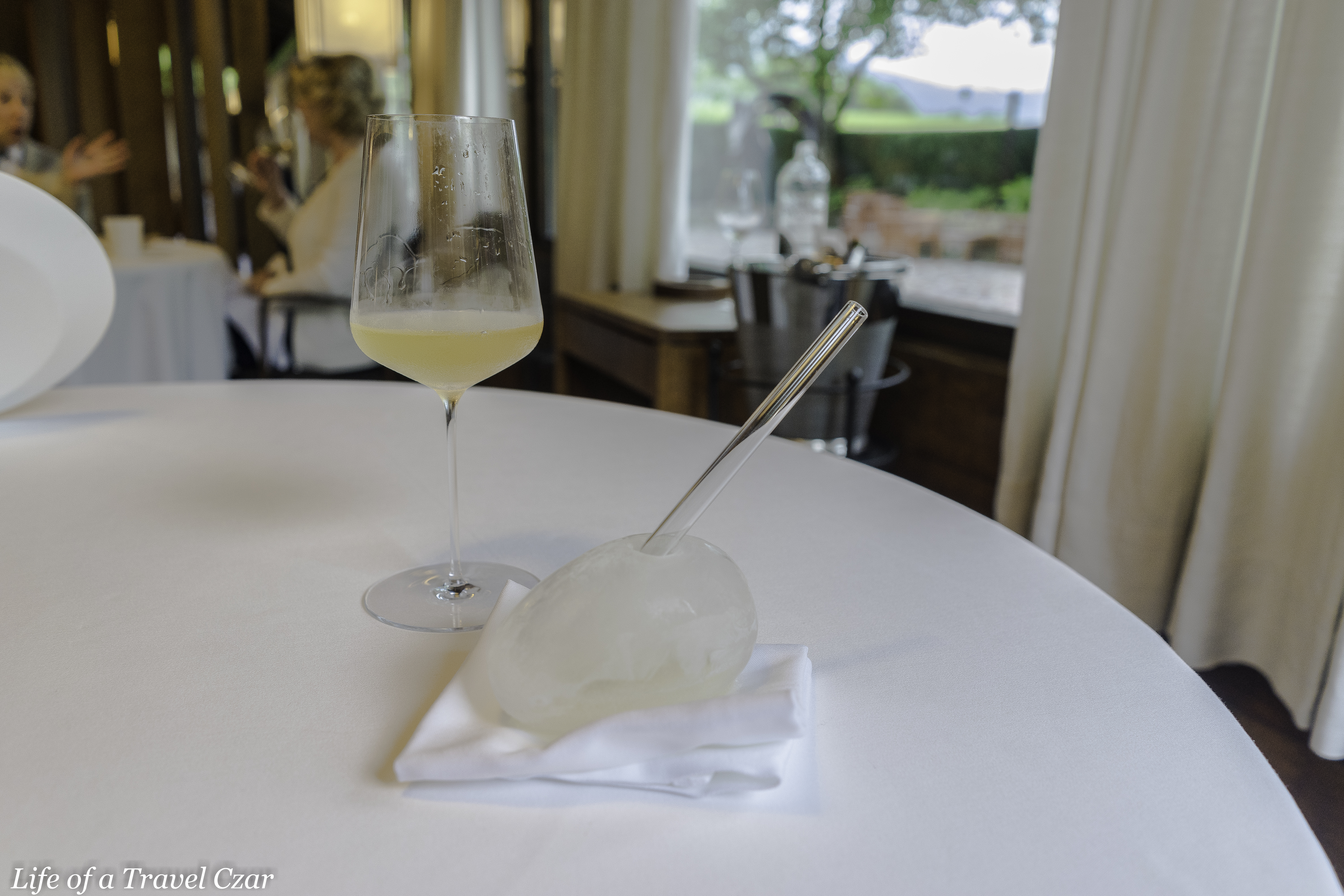
This dish was a frozen consomme of white fish with flowers from the garden. It’s ice cold and served in a chilled egg like dish with a metal straw.
I will give this marks for creativity but it was a miss. The chill hits the taste buds and doesn’t allow you to fully appreciate the consomme. The floral notes are lost and the frozen bits of fish were unappetising to say the least.
Tedorigawa Honryu Sake
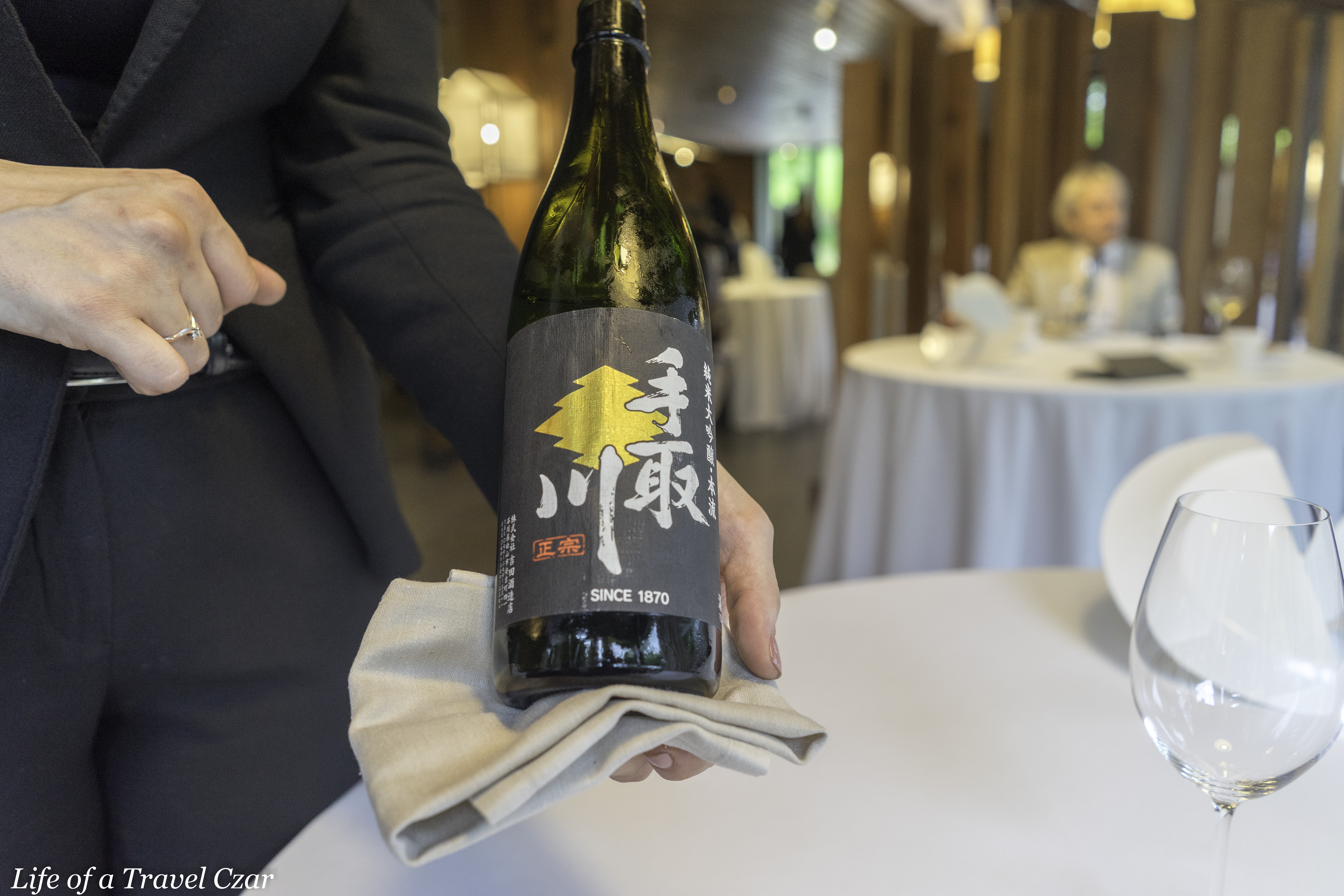
To mix things up, the next pairing is a sake. The sake is pretty straightforward, it’s pure and clean with a little honey-like notes in the finish.
7th Hake in White, “Doburoku”

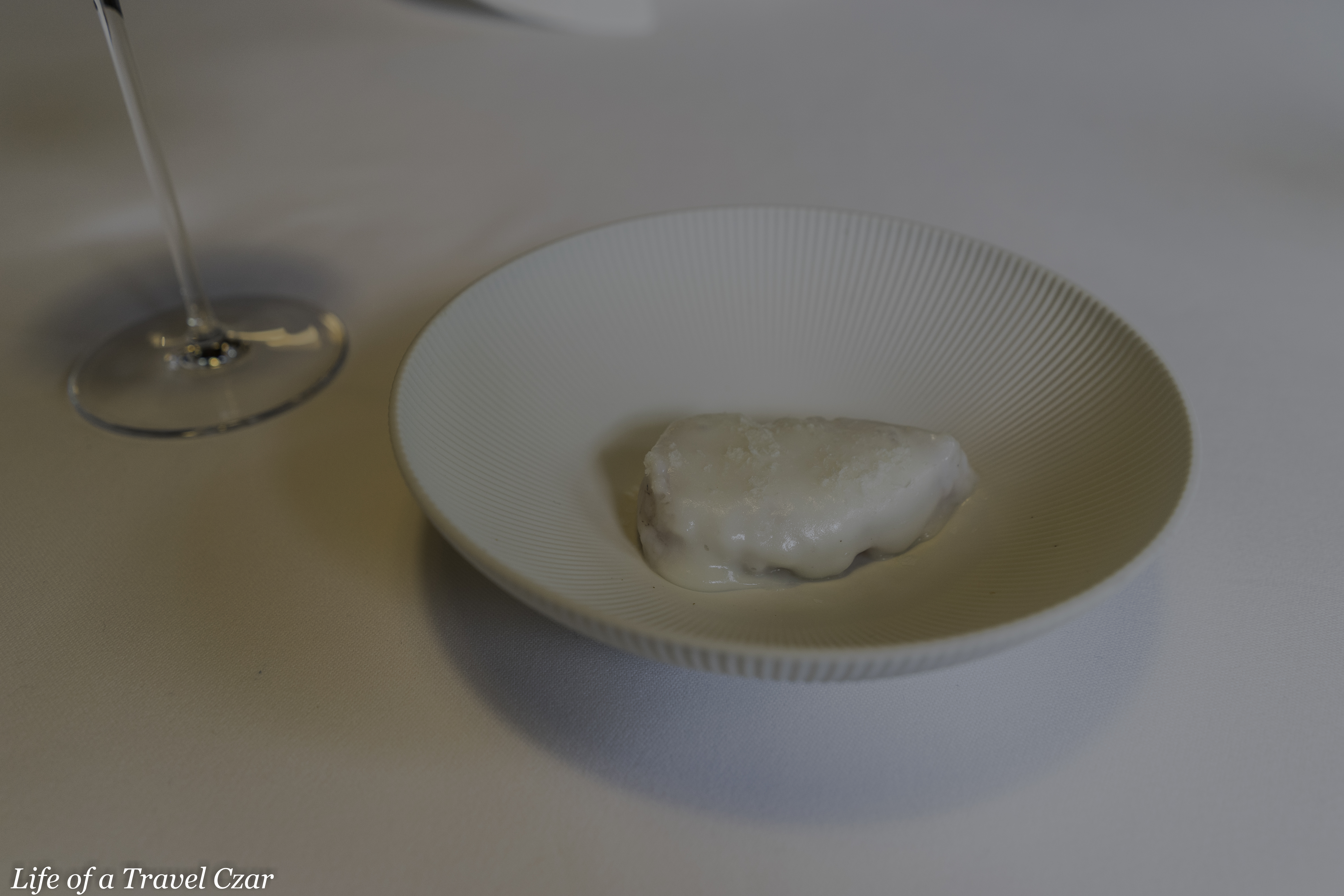
The hake was covered with a mochi fermented cream. It’s a sticky cream and contrasts with the succulent hake. The cleanness of the sake doesn’t interfere with the hake but has mineral purity to cleanse the palate of the sticky mochi.
Minestrone Broth

The next dish is simple but I’ll give it marks for creativity. It’s a clear minestrone soup – with seeds from the vegetables which are the ingredients of the soup at the bottom. It’s a lovely mix of textures with a simple tart flavour which doesn’t wow but doesn’t disappoint either.
Domaine des Ardoisières, Schiste, IGP Vin des d’Allobroges (2014), Savoy, Italy

The next wine is dry white wine from the Savoy region. It’s primarily Jacquère grapes (70%) with the remainding 30% being a mix of Pinot Gris, Roussanne and Chardonnay among others. The wine has lovely citrus aromas with some “earthy” and herb notes. On the palate the wine has a good citrus and acidity with a beautiful flourishing crystalline purity.
Creamy Concentrate: Octopus, Roe and Consomme

The dish is basically an octopus with roe and a light salty sauce. The rich sweet octopus and salinity of the roe and sauce is lovely. The beautiful acidity and mineral notes of the wine pairing work a treat.
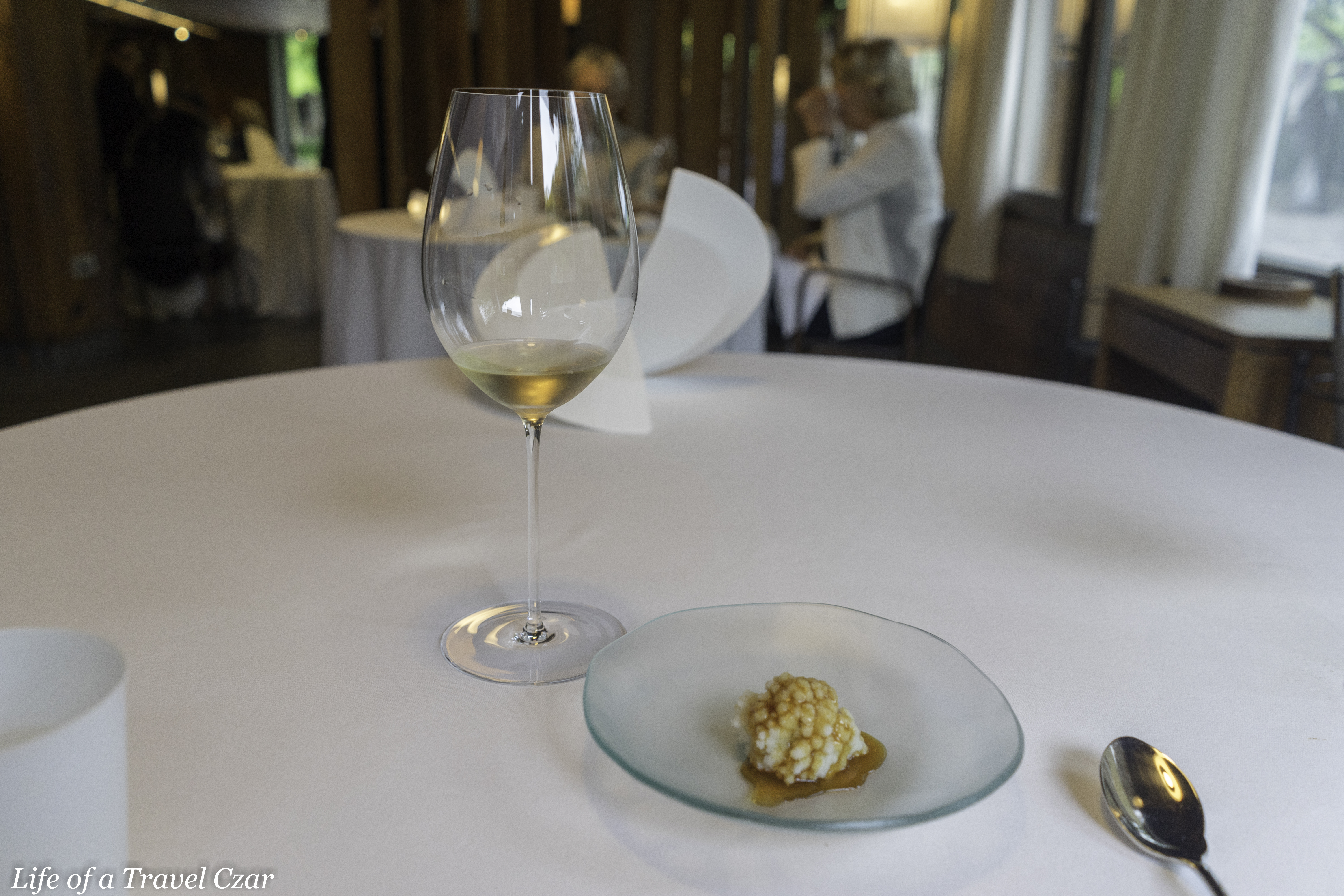
Noëlla Morantin, Sauvignon, Les Pichiaux (2014), Loire, France

Les Pichiaux is a 100% Sauvignon Blanc from Loire in France. On the nose there is good tropical and citrus fruits aromas with some nice floral notes. On the palate it is quite intense, full-bodied with good citrus fruit flavours with good dose of acidity.
Scarlet Shrimp and Corn Sweet

The dish is a Great (Scarlett) shrimp biscuit with sweet corn purée and sauce from the insides of the shrimp under the biscuit. It’s a dream of a dish. The richness of the shrimp is evident in the biscuit and reinforced by the sauce of innards. The creamy corn puree adds a lovely texture and balances the strength of the shrimp nicely.
The acidity in the wine and its full body is a lovely pairing for this dish and I have to say it is a treat indeed.
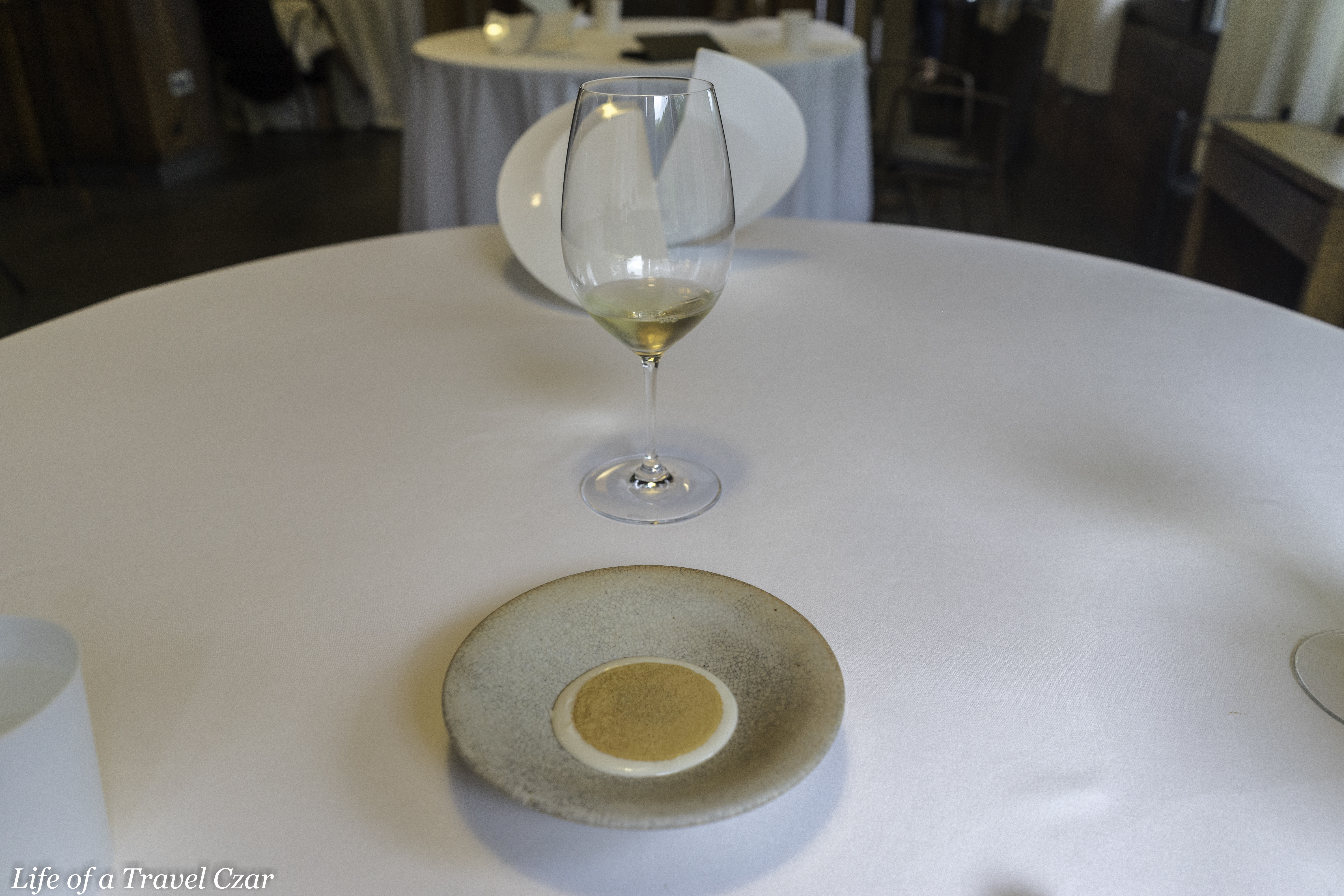
Abadía Retuerta Bianco de Guarda, (2013), Castille & Leon, Spain


The wine is from Castille & Leon in Spain and is 60% Sauvignon Blanc and 40% Verdejo. It’s a rich and compex wine. On the nose it is intense with nice fruit aromas of tropical fruits with a good flow of peach and notes of ginger, mint, florals. There is (after a bit of time in the glass) some smoky and honey notes which appear.
On the mouth the wine continues with the beautiful tropical fruits (primarily grapefruit) with a mix of apples and peach. There are herby, spice and wood notes which appear in the finish. There is good acidity to support the fruit and flows into a long finish.
Pandanus tained roast

The dish is standard with pandas coated mackerel with roe and yogurt from Scandinavia with avocado purée on bottom. The dish was decent but lacked the wow factor.
Somewhere between Puebla and Askola. viili and cream of avocado

The dish is a creamy yoghurt with avocado. It’s quite standard again and a bit lacking in culinary flair.

The wine for the two courses was lovely but would have been more impressive if dishes were a little more creative or had some gravitas.
Lamb

Lamb mochi is lamb cooked into a thick sauce, mixed with mochi and then fried. From a textural perspective it’s a hollow pastry which is crispy. The richness and salt of the lamb is on full display. There are some flowers on top to refresh the palate.
Amontillado VORS (Bodegas Tradición)
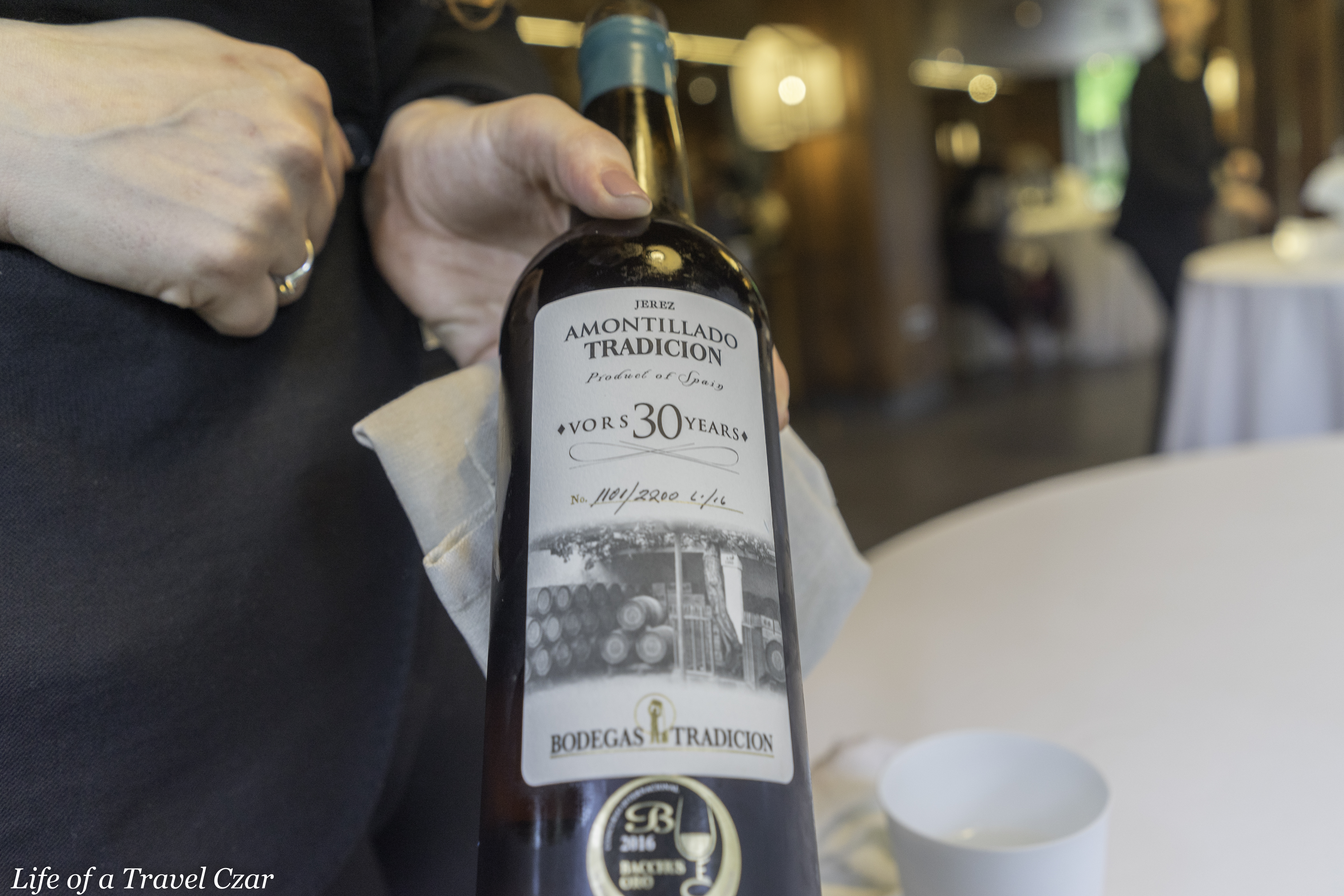
The Amontillado is to be paired with the lamb. But the service falls below standard and I almost have to wave down the sommelier who runs across the room to top-up the wine. It is simply shocking that this could occur at a Michelin star restaurant.
The Amontillado has a nutty aroma, good saline aromas with smoky flow. It’s quite interesting. On the palate it is strong with an explosive flavour of wood, nuts, salt and raisins. Quite shockingly for an Amontillado it’s dry but there is some good acidity.
Thankfully I spotted the error of the sommelier, as it turns out to be the perfect match for the lamb. The lambs richness and natural salinity goes well the acidity, saline and initial sweet notes of the Amontillado. It is a very good pairing.

Tenuta San Guido Sassicaia, (1992), Tuscany, Italy
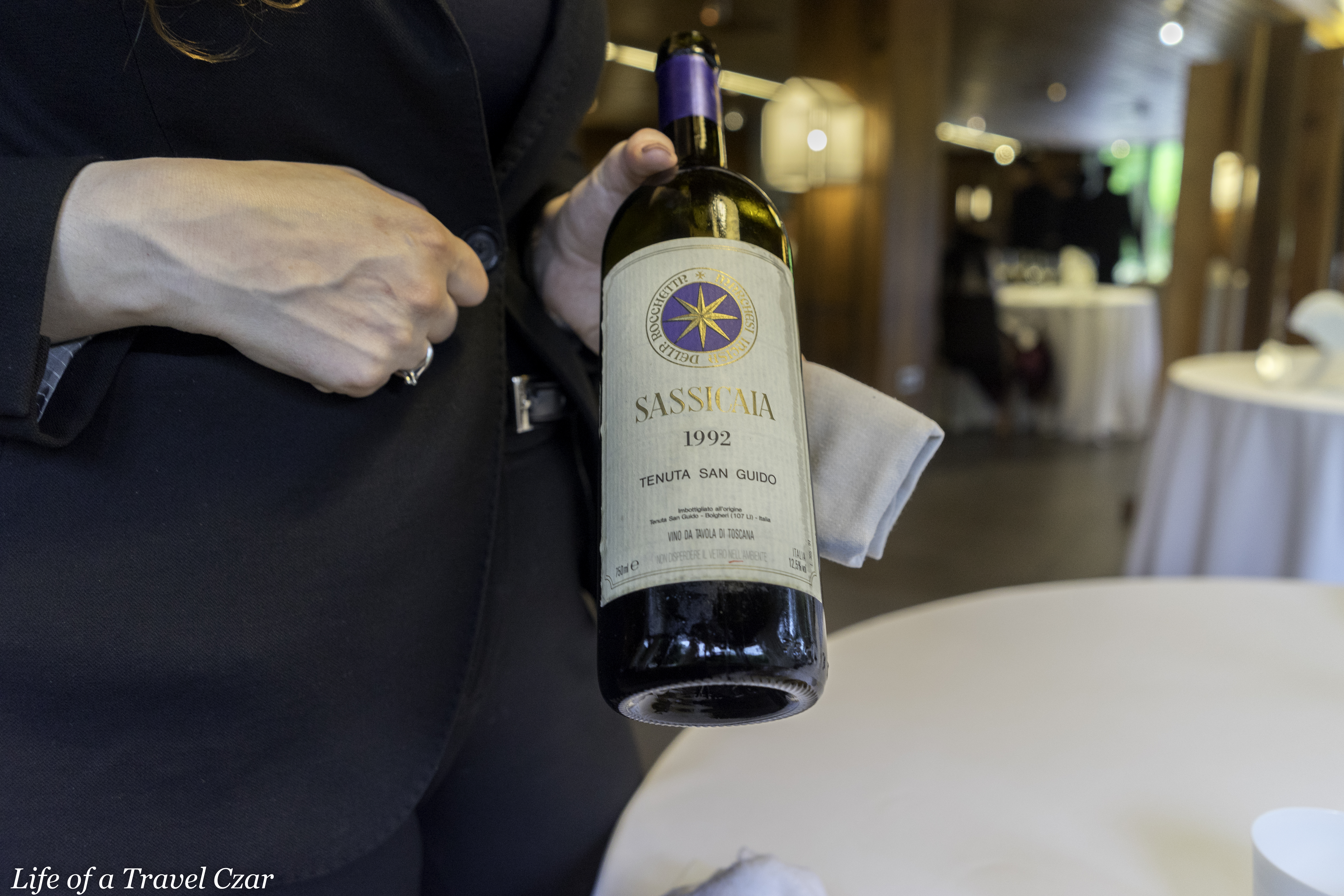
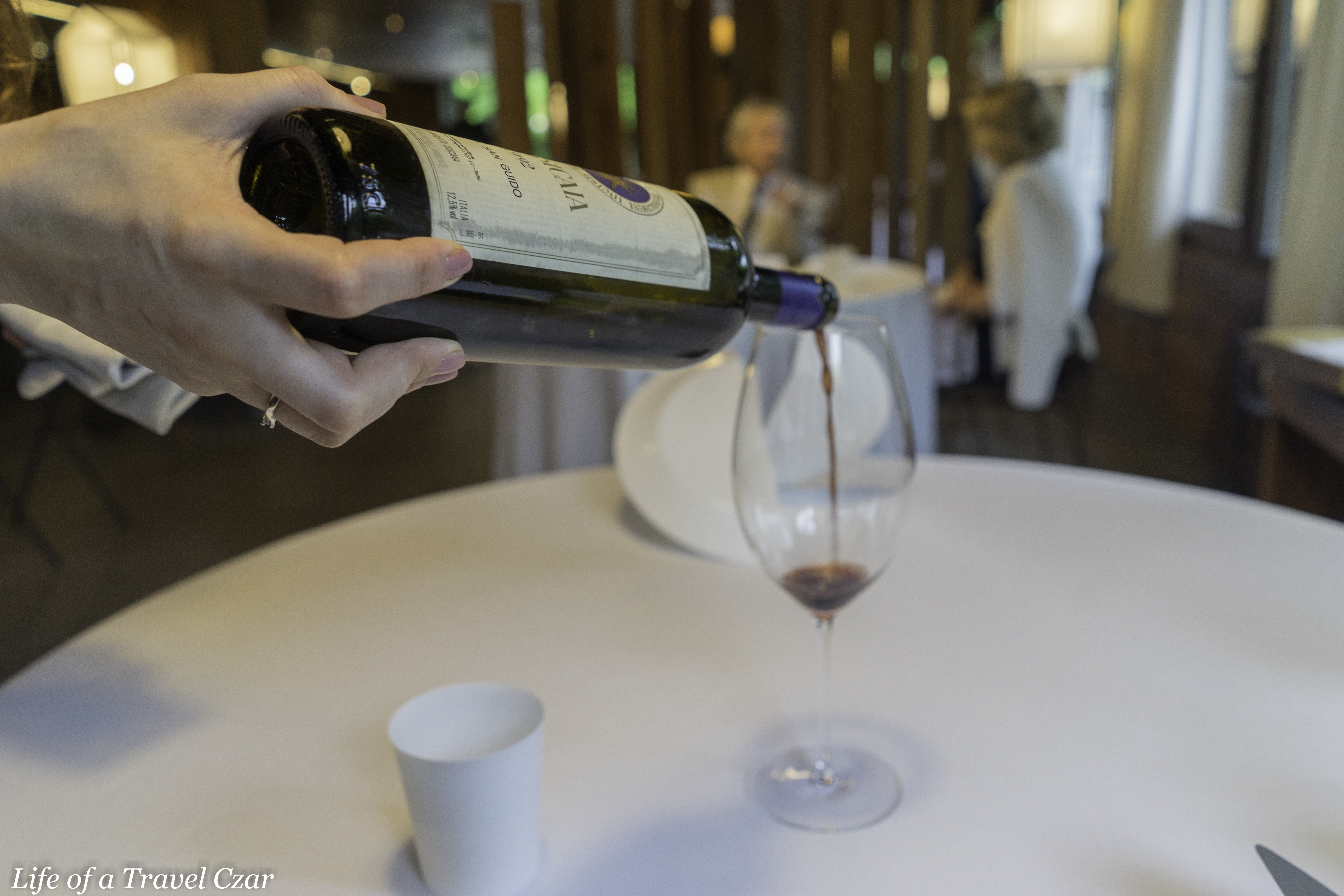
The wine is a dream. It’s a Super Tuscan and my heart flutters at the anticipation. 25 years in the bottle it is sheer anticipation. The wine is primarily Cabernet Sauvignon.
On the nose there is a bit of red fruit, cocoa, smoke, vanilla and some late spice which emerges. On the palate the flow of red cherries, blackberries present themselves. The fruit acidity has dissipated over the years being replaced with an eclectic mix of herb, olive & mineral, cocoa and liquorice notes. There are beautiful fine tannins in the finish which prove oh so alluring.
Baratzuri Zopa

This is a rich black Garlic soup. The dish is rich with a strong pungent flavour which hits the palate like a brick. I do enjoy it and the Super Tuscan is sufficiently strong enough to battle the garlic. A nice experience.
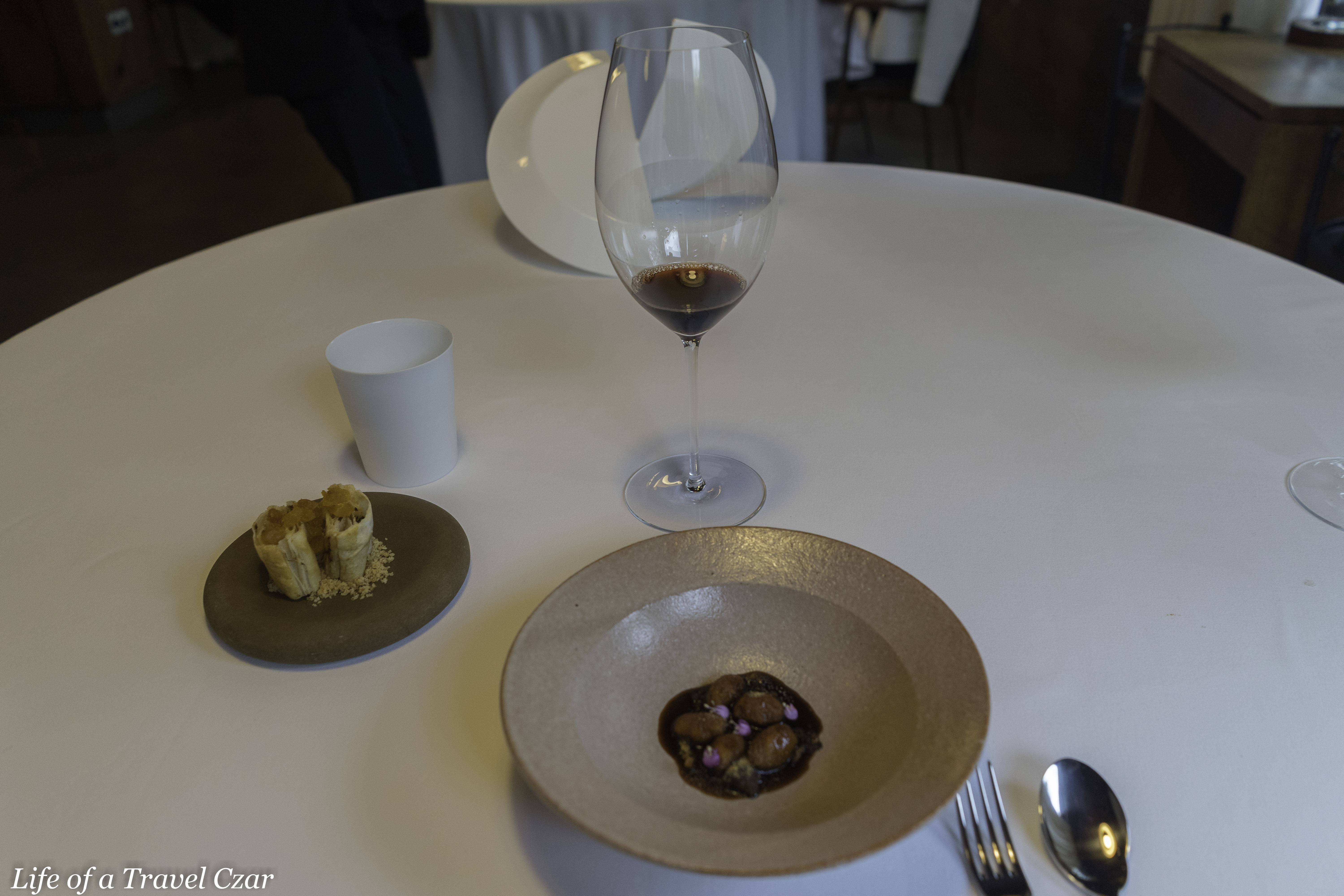
Unleavened Bread Hem and Dry Salt
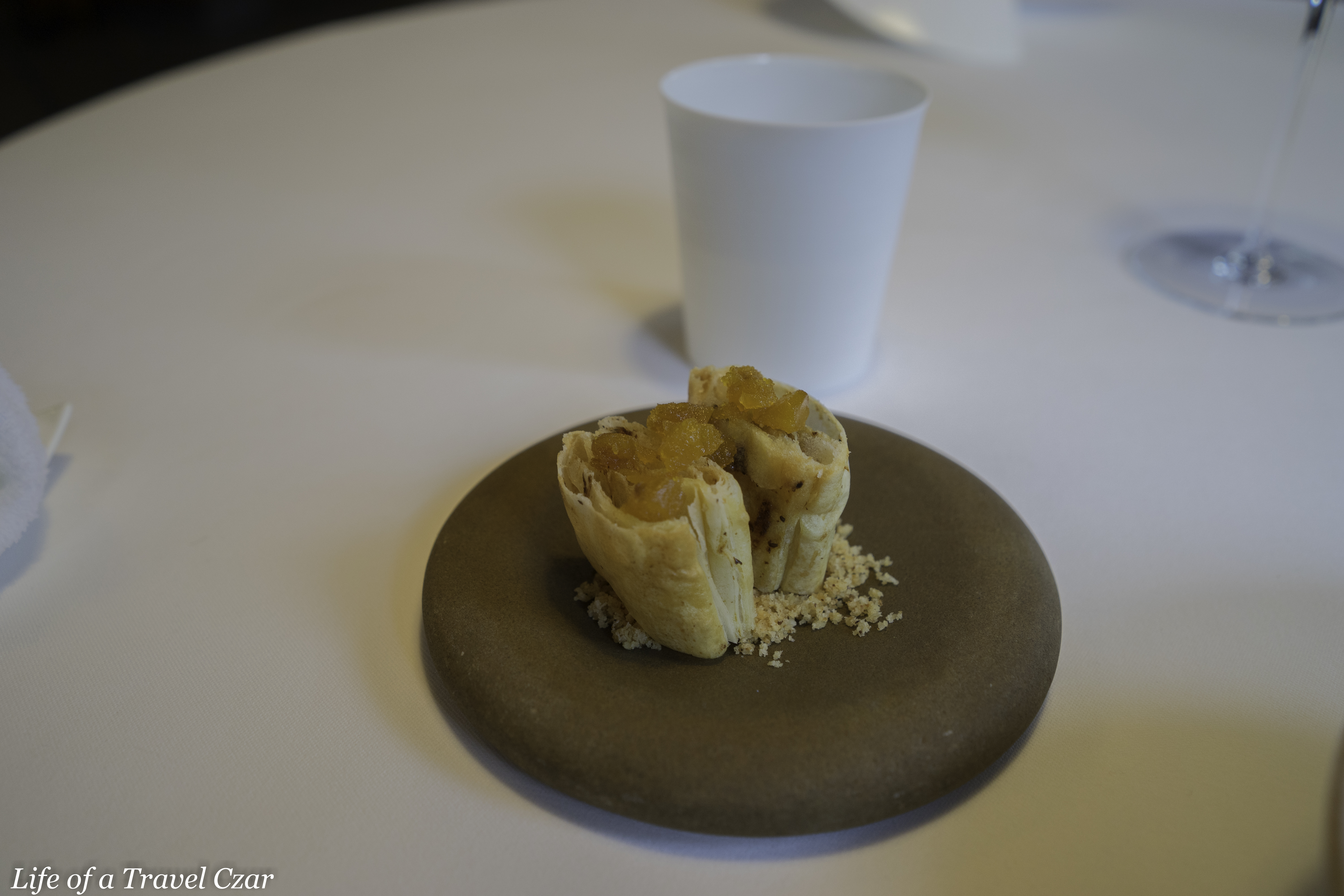
This is a crispy unleavened bread with dry salted mullet roe. The richness of the roe and its deep salinity is lovely. The dish does tick the boxes from a textural perspective with the crunch of the bread and the dry powdery roe. A dreamy experience indeed, though not sure it should have been paired with the Super Tuscan.
Soldier striped shrimp from the Alboran Sea
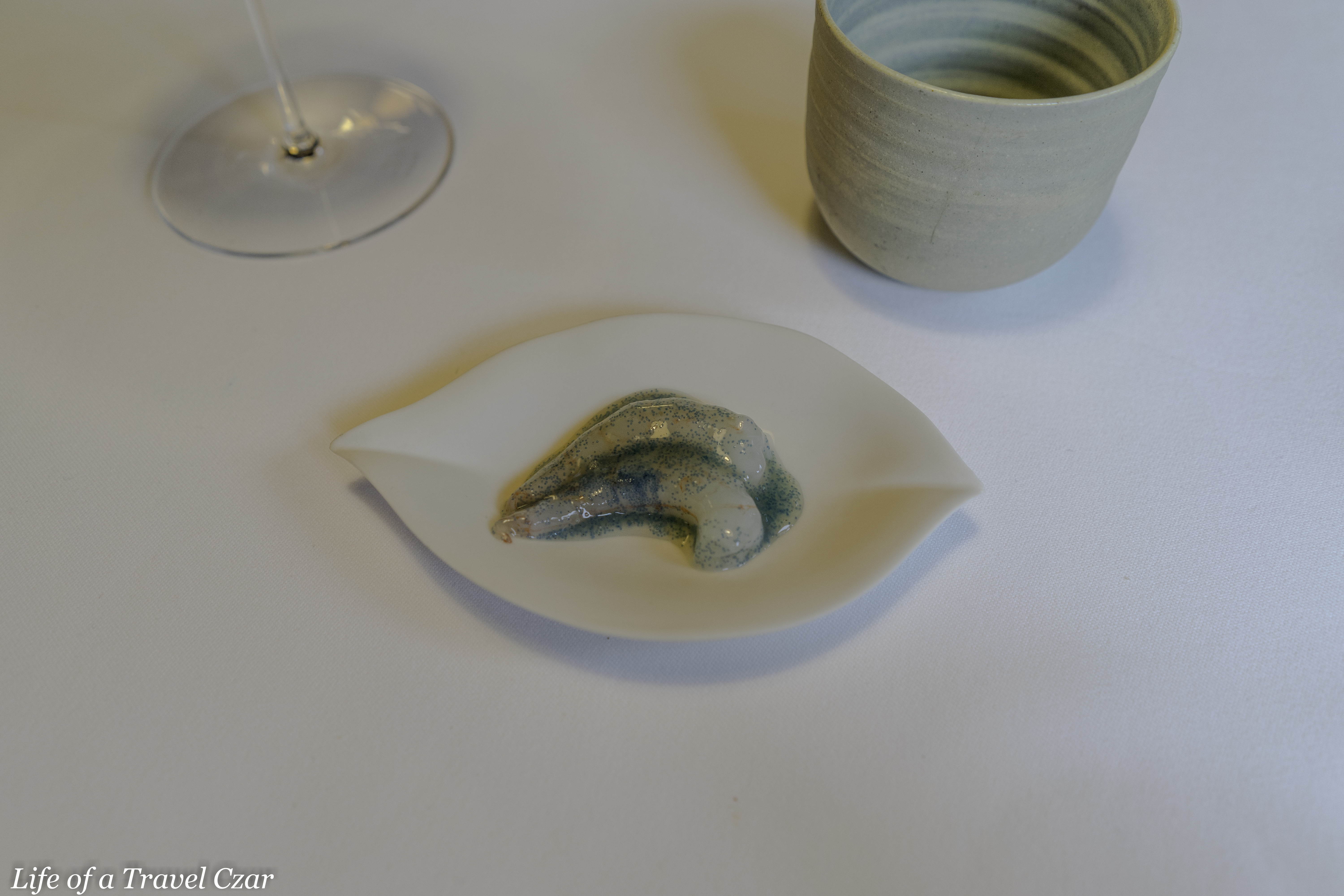
This is simplicity at its best, the striped shrimp with it’s electric blue roe. The shrimp is sweet and the roe has a beautiful indescribable richness to it. The raw nature means the sticky succulent texture is a dream for the palate. A dream indeed.

About Hirezake: Heated “manzanilla” and toasted fins
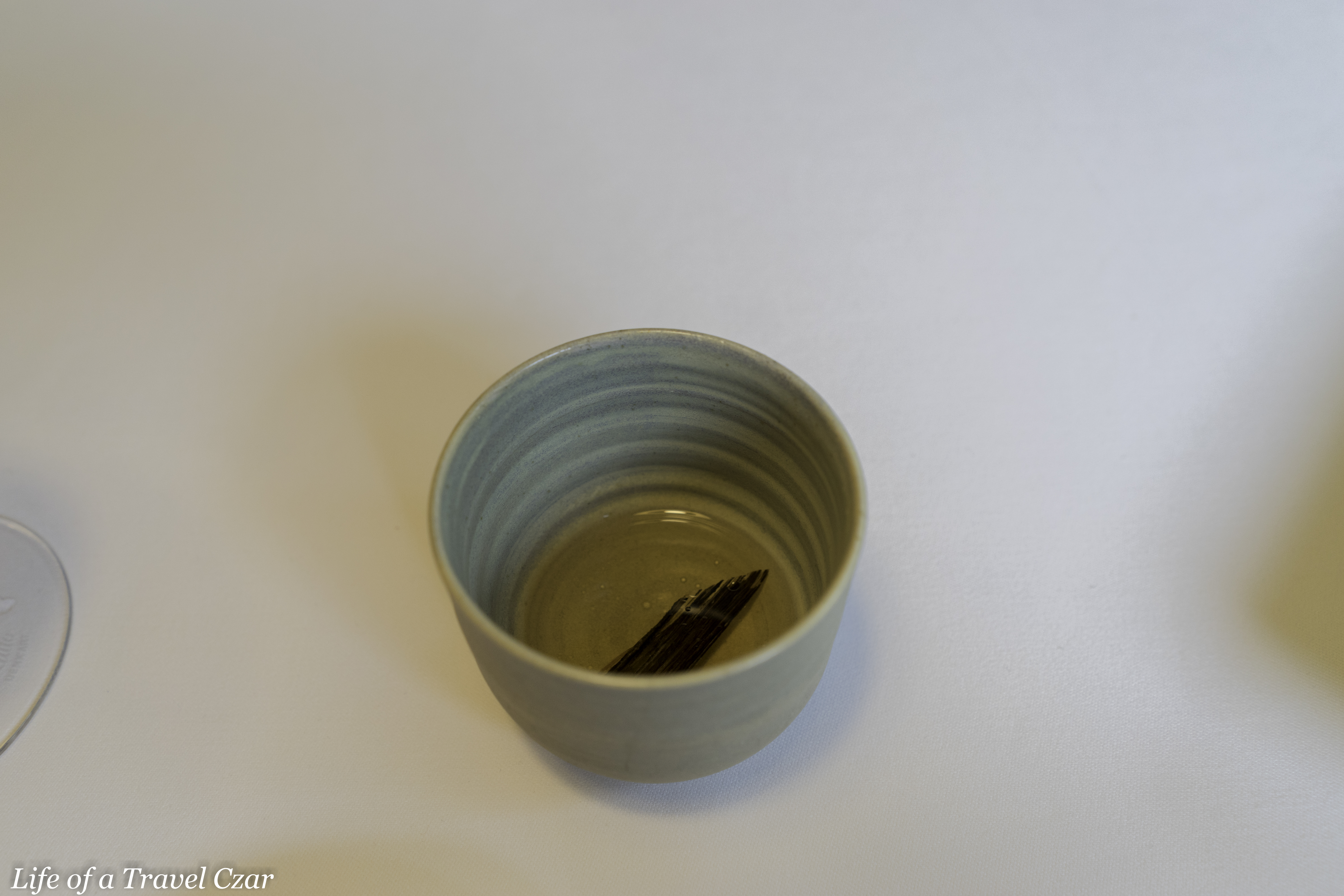
This is a warm sherry with a groper fin. It’s a mix of crunch and the sweet tart acidity of the sherry. It’s a decent simple dish and I’ll give it a score for creativity.
Does the Truth Really Matter

This is pigeon skin with some sauce. It’s salty with a bit of a float taste. It’s oily with a rich flavour. I did actually enjoy it.
Bodegas Vega-Sicilia, Valbuena 5°, (2010), Ribera del Duero, Spain


The pigeon is paired with a Tempranillo. Actually it’s mostly Tempranillo but with 5% Merlot. The wine has good aromas of berries, licorice, floral notes and some really good earth at the end. It is a full bodied wine with good black fruit flavours (black cherries and plums) with a lovely long finish. The richness on the palate is balanced by some reasonable tannins.
Laudum Fondillón Gran Reserva 1987, Monastrell, Alicante, Spain
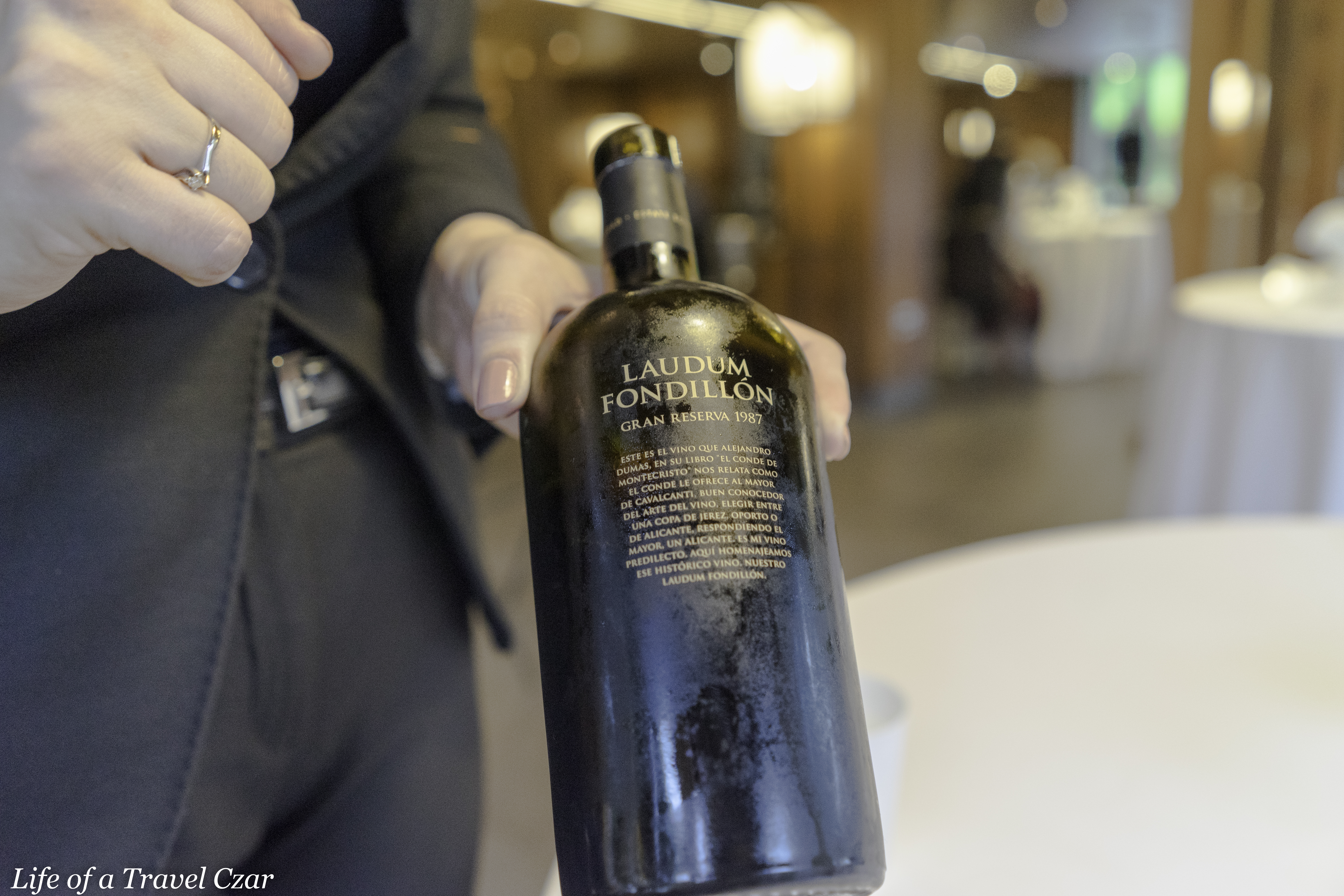

This dessert wine is from the old vineyards of Alicante. The Monastrell grapes are selected carefully and are harvested when they very ripe to increase the sugar concentration in the wine. The wine is then aged in oak barrels before being bottled.
The result in a pretty amazing dessert wine. There are some pretty intense aromas; with stewed plums, dates, raisins, figs with some lovely notes of sweet liqueur mocha, nuts and leather creeping in. As it flows on the palate it is interesting. It has good balance, a beautiful silky texture with some nice acidity to balance the concentrated fruit sugars. It has a long finish with some brioche and spice notes to sign-off in the finish.
Tigernut ice cream with fresh fried rice
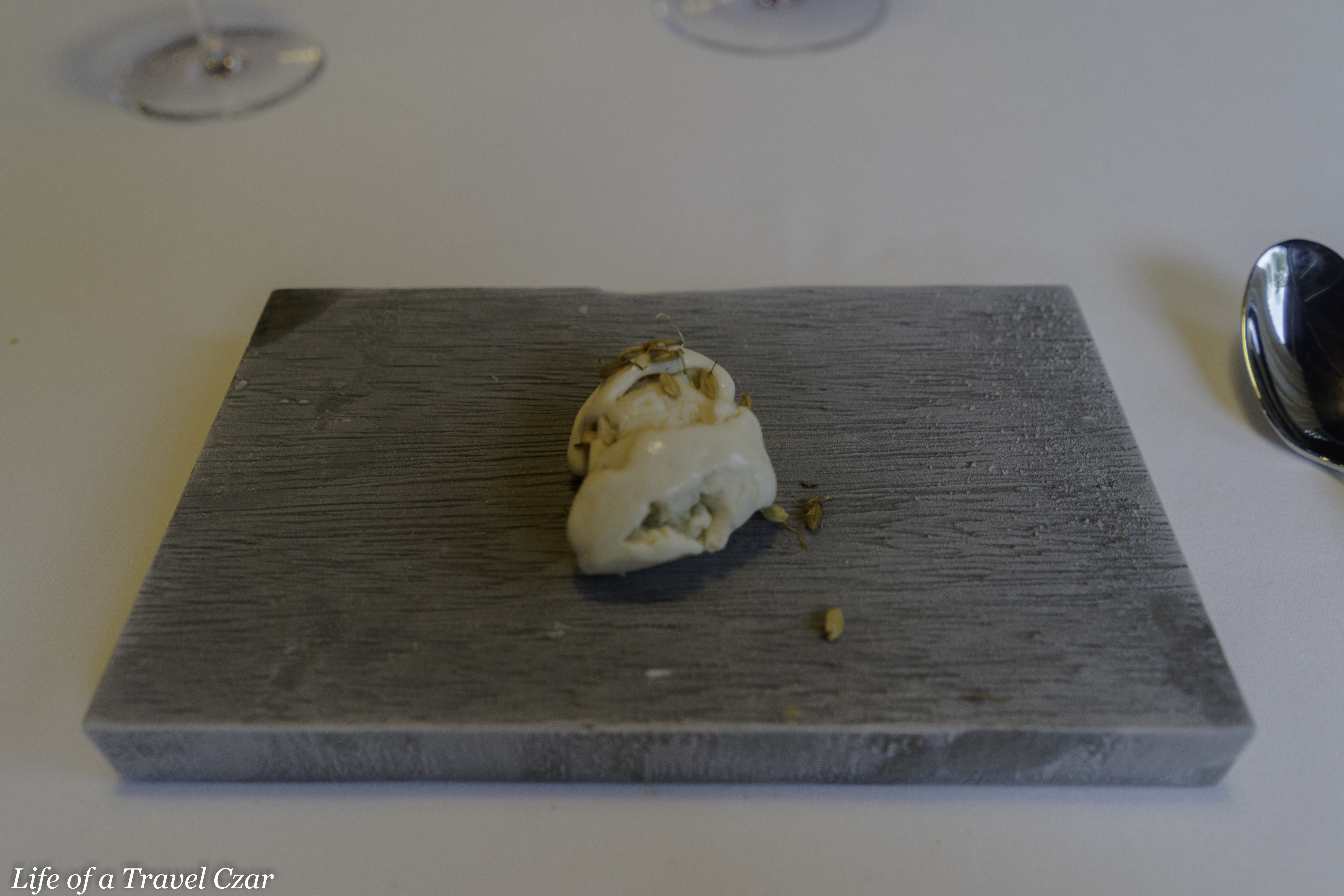
The tiger nut ice cream has a lovely nutty flavour with a rich creamy texture. The fried rice adds some crunch to the dish which is lovely. The complexity of flavours in the Laudum Fondillón is a treat and flows nicely with this dish.
Noble Rot
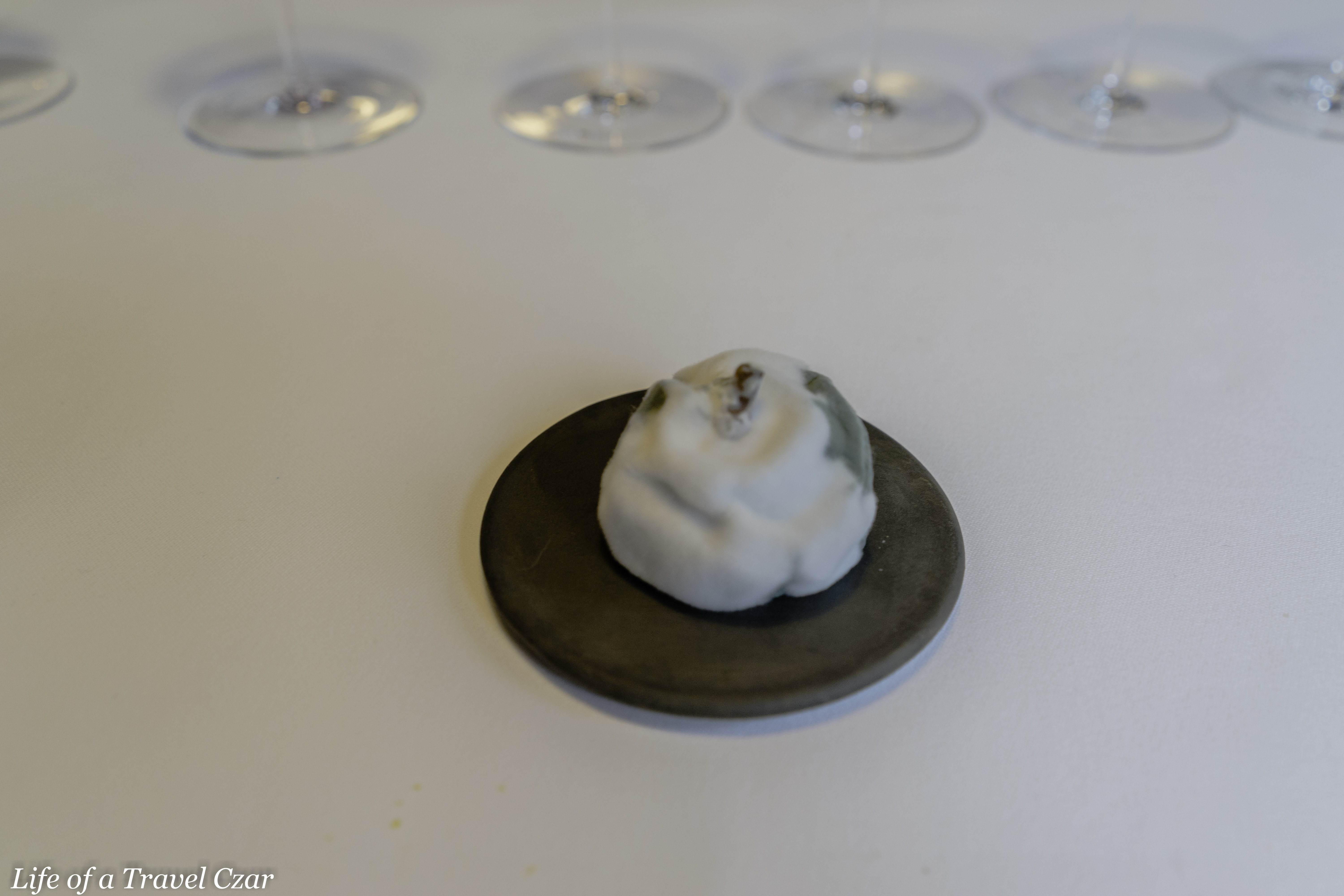
This is an pear inoculated with a mix of penicillin & the rot found in the dessert wine. It’s quite tasteless (albeit with a hint of tart fruit) and has spongy texture. It wasn’t a dish which impressed.
Four Dessert Wine Pairings
Prinz von Hessen Riesling (1994)
The real highlight of the dish was the wine pairings; four premium dessert wines.

It’s a lovely sweet wine with hints of tropical fruit (primarily nectarines and pineapple) on the nose. On the palate there is a little hint of pear, honey, spice which delivers a real sugar hit.
Chateau d’Yquem (1999)
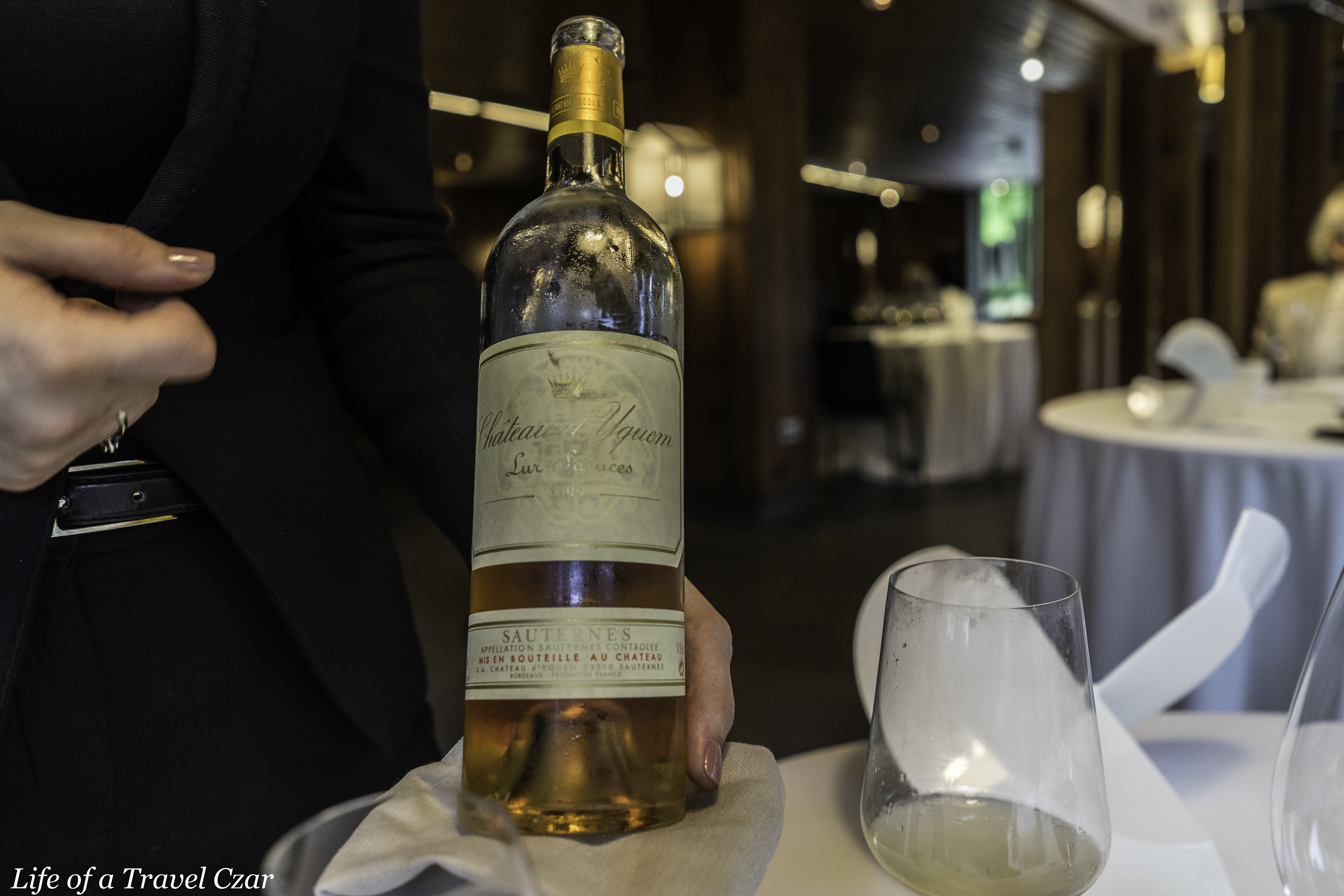
This is a stunner. The Sauternes imprint is unmistakable. The bouquet is intense with yellow and candied fruits with light floral and honey notes. On the palate there are nice citrus (lemon), tropical fruit and a light smoky custard flow with good acidity and oak to support the fruit.

Weinrieder Riesling Eiswein (1998)

There are good tropical and floral aromas. On the palate there is a strong concentrated yellow fruit flavour – it’s pure sugar. The texture is thick and syrupy and has some balance with the acidity, but I am not a sweet tooth so I do focus on the other wines in the pairing.
Chateau Dereszla Tokaji (1994)

This ones a little more complex. It’s got lovely aromas of apricot, raisins, brown sugar (actually not quite, it may be caramel – it wasn’t smoky ) and citrus peel. On the palate it is sweet, continuing with the apricots and honey. The smoky caramel emerges more definitively on the palate. There is still some decent acidity and a lovely long finish which makes this on par with the Chateau d’Yquem in the tasting.

If I had to describe this; forget the pear and focus on the Sauternes and Tokaji which are amazing!
In Dubiis, Absinthe

Final dot of chicken broth reduction. It’s salty with a good flavour but doesn’t particularly wow in the finish.
Kitchen Tour
All diners are treated to a little tour of the kitchen.
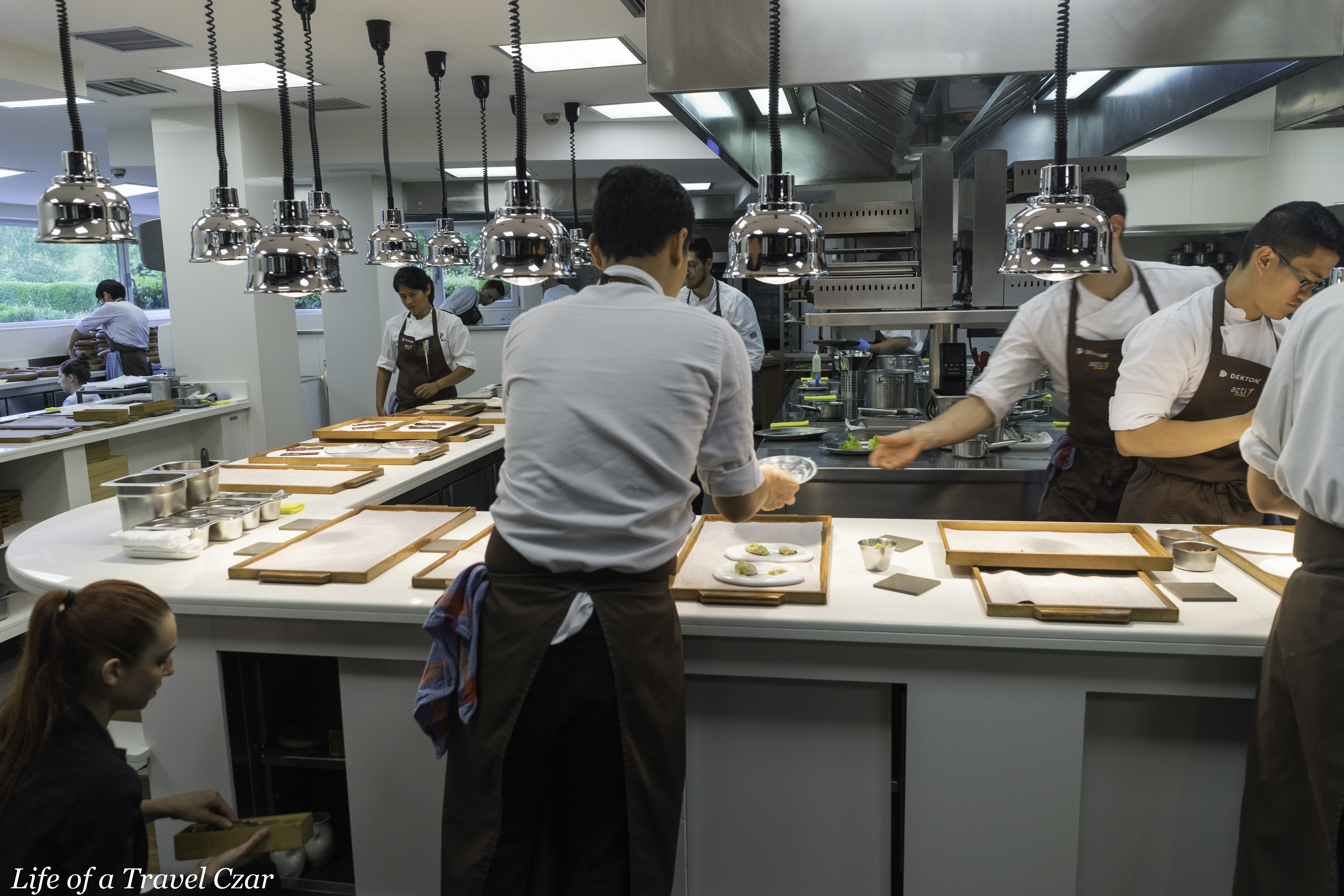
Chocolates
There is a tower of chocolates (different types of chocolate stored in wooden stacked boxes with wood shavings in them.

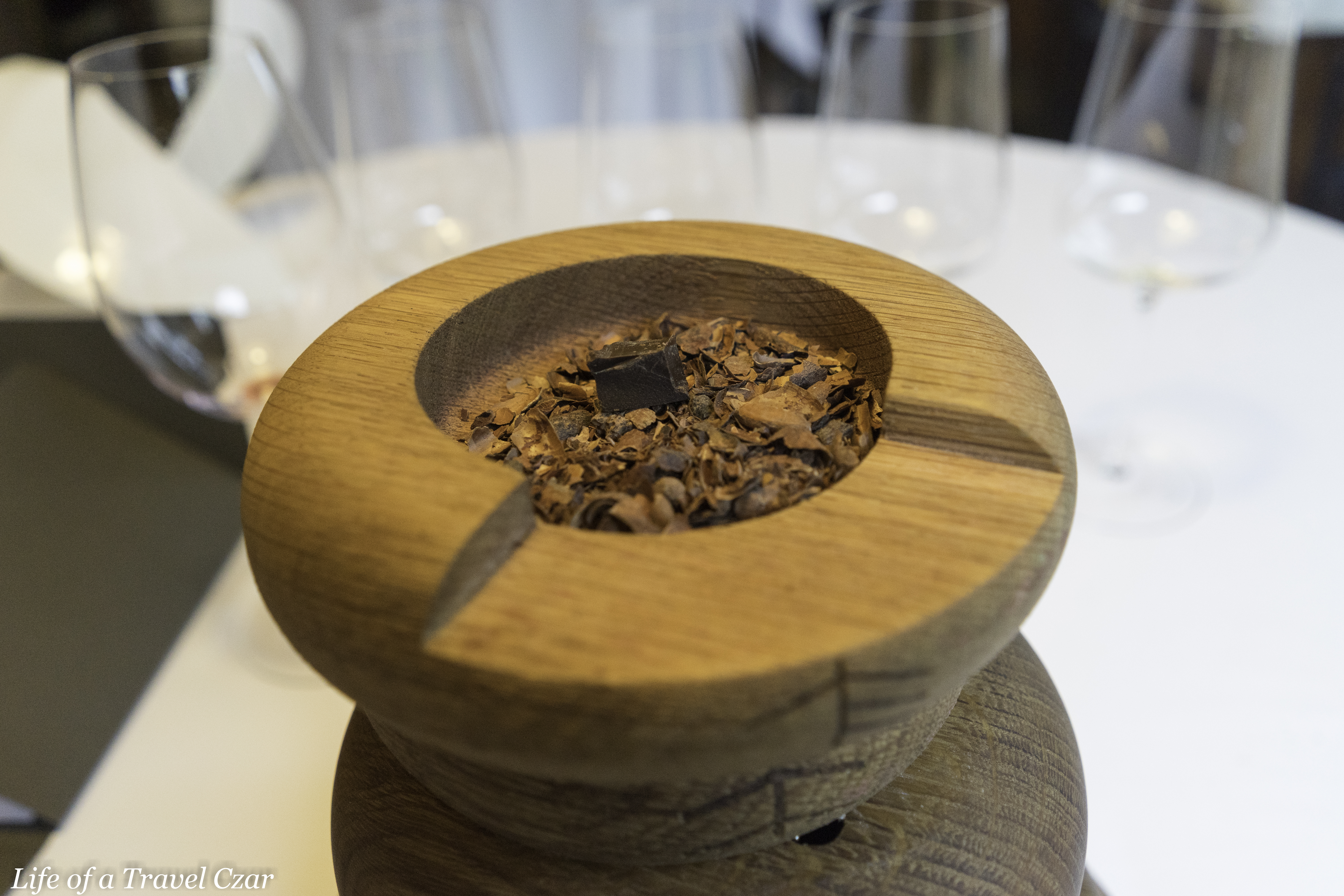
Coffee
I finish with a coffee to wrap up the afternoons proceedings.

Overall
So what are my thoughts – the experience is 25 dishes and matched wines. I am a reasonable person and I don’t expect to like every dish, particularly when it’s experimental molecular gastronomy. However the service has let this restaurant down and post my lunch this is confirmed by other diners which have dined there before.
I typically don’t review every fine dining restaurant I dine at (typically only 10 – 15% of restaurants I dine at every year are reviewed). If an experience is not enjoyable, I normally don’t write about it. So why have I penned about Mugaritz? Firstly is a Michelin Star restaurant and secondly there were some fine experiences worth telling you about (Lobster Roe with Tigers Milk) and there were some really top notch premium wines which were enjoyable.
But I think there are a couple of salient points to consider:
- The restaurant is understaffed given its complexity. Not every table has the same menu and hence the waiters and sommeliers are scrambling to ensure everything is delivered correctly. This leads to unacceptable mistakes and some pretty sloppy service (wine pairings not being served, dishes being brought out at the same time and general confusion). I ask for the wine pairing to be printed and am promised it would be emailed to me, but alas it never arrives.
- Dishes and wines are not explained clearly and numerous follow-up questions are the go to seek clarification. Given the complex nature of some dishes, a clear explanation should be the norm, not the exception.
- I think to be a Michelin Star or indeed a Top 50 – there needs to be the “extra mile” of service. I reflect on my prior 10 / 10 experiences:
- Eleven Madison Park; had a very personalised service and quirky dishes which resulted in good engagement with the staff
- Martin Berasategui and Per Se; personally tailored an amazing wine pairing through a good discussion. Per Se in particularly was across each and every item of produce on the dish.
- Nobu; Over serviced at each point (no empty wine glasses on the table, good understanding of produce and tailored a menu to suit)
- Le Louis XV; Overdid the basics (huge selection of breads and cheese), had a premium wine list, re-set the entire table setting for dessert and nailed the silver service standard.
At Mugaritz the service fell well short of what I was looking for, some of the dishes missed the mark and the base wine chosen for the pairing was not a stand-out.
